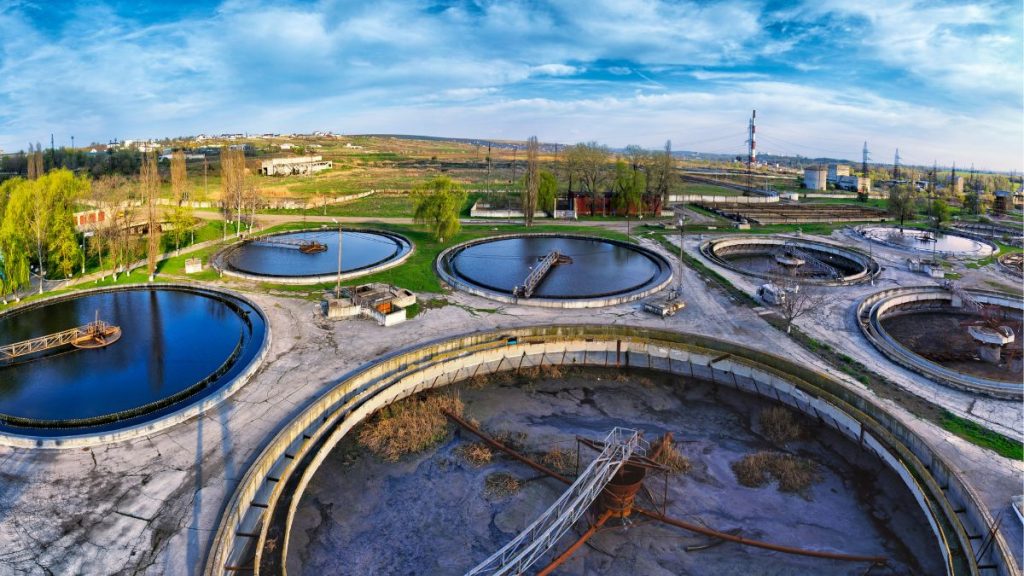Unpleasant odors from wastewater treatment facilities are not only disruptive but can also raise various environmental and social issues. Wastewater odor control is a crucial aspect of wastewater management, both for industrial and domestic wastewater treatment plants. This article will delve deeper into the causes of odor in wastewater, the types of control methods available, and why odor control is crucial for responsible and sustainable operations.
What Causes Odor in Wastewater?
Unpleasant odors in wastewater arise from biological and chemical processes that occur during wastewater storage or treatment. Some of the main causes include:
1. Anaerobic Processes
When wastewater lacks oxygen, anaerobic bacteria dominate the decomposition process. This process produces compounds such as hydrogen sulfide (H₂S), which smells like rotten eggs, pungent ammonia (NH₃), and volatile organic acids, which produce other unpleasant odors.
Read Also: Aerobic Anaerobic Wastewater Treatment: Definition, Systems, and Comparison
2. Specific Industrial Waste
Certain types of industries, such as food and beverage, petrochemical, textile, or meat processing, produce waste with a high organic content. This content tends to decompose quickly and produce odor-causing compounds.
3. Activated Sludge and Holding Tanks
Processing units such as equalization tanks, primary clarifiers, and sludge holding tanks are potential sources of odor. The accumulation of organic matter and anaerobic fermentation processes in these areas are the main triggers of strong odors.
4. Sewers and Pipelines
Long, tightly closed networks of pipes and wastewater lines often lack oxygen, triggering anaerobic reactions that produce odors.
Understanding the source and type of odor is crucial as a first step in determining the appropriate control strategy.
Types of Wastewater Odor Control
Wastewater odor control strategies can be classified into chemical, biological, and mechanical approaches. Each has its own advantages and applications depending on the type of facility and the severity of the odor.
1. Chemical Odor Control
This approach uses chemicals to neutralize, oxidize, or deactivate odor-causing compounds. Some commonly used chemical methods are:
- Oxidant Dosing: Using substances such as sodium hypochlorite (NaOCl) or potassium permanganate (KMnO₄) to oxidize odor-causing compounds like H₂S and mercaptans.
- pH Adjustment: Changing the pH of wastewater to prevent the release of gases like H₂S into the atmosphere.
- Chemical Adsorbents: Using activated carbon or other materials that can absorb odorous gases.
- Chemical Deodorants: Used in the form of sprays or fogging to neutralize odors in open areas.
2. Biological Odor Control
This method involves certain microorganisms to naturally decompose odorous compounds.
- Biofiltration: Flowing odorous air through biological media such as soil, compost, or synthetic media containing microbes that break down H₂S and ammonia.
- Biotrickling Filter: A variation of the biofilter that uses layered media and a continuous flow of water to maintain optimal microbial activity.
This approach is environmentally friendly and highly effective in the long term, but requires maintenance of the media and the stability of the microbiological process.
3. Mechanical and Physical Control
This approach focuses on system design and engineering to minimize odor release.
- Enclosure System: Encloses areas such as tanks and aeration basins to isolate odors.
- Ventilation and Air Collection: Directs odorous air to a treatment unit such as a scrubber or biofilter.
- Activated Carbon Filter: A filtration system that uses activated carbon to absorb odor-causing gaseous compounds.
- Mist or Vapor Suppression System: Uses water spray or chemical solutions to suppress the release of odorous gases from the water surface.
Read Also: What Is Activated Carbon? Types and Benefit
Why is Odor Control Important in Wastewater Treatment?
Why is odor control an essential aspect of wastewater treatment? Here are some key reasons:
1. Maintaining Relationships with the Surrounding Community
Wastewater treatment facilities are often located close to residential areas or other industrial areas. Pungent odors can trigger community complaints, environmental protests, and even lead to sanctions from local governments. Odor control is an essential part of the social license to operate.
2. Complying with Environmental Regulations and Standards
Many regions have established emission thresholds for gases such as H₂S. Failure to control odors can result in legal violations and administrative fines.
3. Protecting Occupational Health and Safety
Exposure to toxic gases such as H₂S or ammonia at high levels can harm workers near the installation. Odor control is also part of efforts to create a safe work environment.
4. Improving Corporate Image
Companies or institutions that manage their waste properly are considered more environmentally responsible. This contributes to their reputation and long-term operational sustainability.
Supporting Wastewater Odor Control with Reliable Solutions
When addressing the challenge of odor in wastewater treatment plants, each facility has unique needs. This is where a precise, integrated approach tailored to the specific conditions is crucial.
Lautan Air Indonesia is here to support industries and agencies in managing odor emissions more effectively. With extensive experience in water and wastewater treatment, we provide a variety of technical support and appropriate product selection to help maintain environmental quality and the comfort of those around us.Want to learn more about odor control options for your facility? Lautan Air Indonesia’s technical team is ready to help evaluate and recommend the appropriate approach to support your operational success. Contact us here and schedule an appointment with our team.



